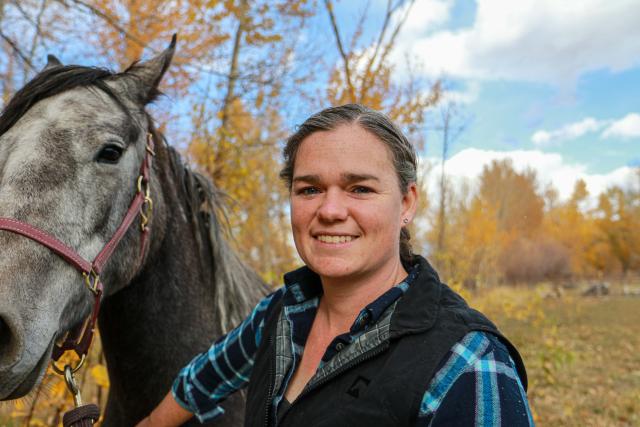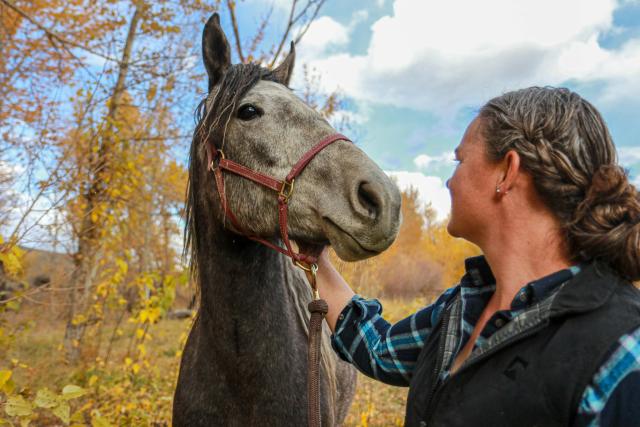You are viewing ARCHIVED content published online before January 20, 2025. Please note that this content is NOT UPDATED, and links may not work. Additionally, any previously issued diversity, equity, inclusion or gender-related guidance on this webpage should be considered rescinded. For current information, visit https://www.blm.gov/blog.
For the love of a Challis wild horse
By Special Contributor Paula Cook
One thing is obvious when you drive up to the Keller property outside Challis, Idaho: these are industrious and busy people, obviously not afraid to take on a project and see it through to completion. Fence posts were set awaiting the fencing that rested nearby and construction materials were neatly stacked and staged, ready to be incorporated into the property landscape.
The next thing you notice is that this is a home of people who love animals. I mean, they really love animals. The front pasture is populated with a remarkably harmonious array of critters; adult and baby pigs rush to the fence looking for a scratch or a snack while a few brightly collared goats stand back, watching to see if it is worth their time to approach. A couple of sweet farm kitties saunter up and rub our legs while a watchful hound dog keeps track of us from behind the wire of his large kennel. Three beautiful horses share the roomy pasture with their unlikely companions, two light gray mares that appear to be of Arabian descent and a gorgeous darker filly that you would swear was of registered show stock were it not for the white hieroglyphic letters on her neck that denote her as a captured wild mustang.
Welcome to the home of Katelynn Keller, wild mustang adopter and happy participant of the Adoption Incentive Program offered by the BLM.
Katelynn walked purposefully out of the house and greeted us warmly, her eyes exuding welcome and a sparkling intelligence. We were in Challis filming a documentary commemorating the 50th Anniversary of the Free Roaming Wild Horse and Burro Act, and Ms. Keller graciously accepted our request to meet with her and talk about her adoption experience. When asked if she might be able to catch her mustang filly and have her stand with us during the interview Katelynn readily agreed. We watched her walk into the pasture, halter in hand, and the dappled gray filly caught her instead, walking right up to her and nuzzling her pocket for the treats she knew would be nearby.
We walked behind the house and down a small hill to the west side of Keller’s property to film. The backdrop for our video was absolutely stunning; trees were in their full fall garb, proudly wearing shades of yellow ranging from a deep rich gold to a lighter hue reminiscent of an early blooming daffodil.
Katelynn was just as open and fun to talk to as she looked. She cheerfully told us the story of her decision to adopt not one, but three mustang weanlings gathered from the Challis HMA in 2019. She explained with a chuckle that she was able to sell her husband on the idea of adopting multiple horses by illustrating for him how far the incentive dollars would go toward further establishing their facilities as well as buying enough hay for not only the mustangs but also augmenting the feed supply for their existing herd of horses.
Keller said she had long wanted to adopt a wild horse, particularly from the Challis herd, and when the BLM announced the $1,000 incentive program she knew it was the right time. No stranger to gentling unhandled animals, Katelynn had previously halter-broken and started young range horses raised on her husband’s family ranch in Challis as well as rescuing and retraining other breeds of equine, so she already had the skills necessary to begin the conditioning which would initiate her new mustangs into a domestic lifestyle.
After several visits to the wild horse holding corrals in Challis, Katelynn decided upon three weanling mustangs. The Keller family did not need to add that many horses long-term, but she pragmatically planned to gentle and train all of the young prospects, then determine which one or two would fit in with her existing herd dynamics and suit the long-term goals of her family, finding appropriate fits with other adopters for the horse or horses that she would not be keeping.
As the gentling process progressed Katelynn said the gorgeous gray filly, who she named Pearl, was obviously the best fit to incorporate into her program. When she received title to the horses after the one year waiting period Keller already had good homes identified for other two mustangs, and she described how well they had adapted to life with their new families. “They just love them!” she said with a grin.
We were curious what it had been like, taking on three just-weaned youngsters, unused to human interaction and hardly touched just weeks before. “They were just like regular horses.” Keller asserted. Each had their own personality and quirks to work through, the same as horses she had worked with before in her training program, and the same training methods she had utilized on her domestic charges were effective with these new babies.
Pearl stood patiently for most of our interview, gently nosing her handler now and again for the treats she carried in her pocket; raising a front leg to paw the ground when she had had enough. Keller corrected the behaviors with quiet confidence, pushing the inquisitive nose back to where it belonged and backing the filly up a few steps when she started to get too pushy. “She’s having a lot of baby moments right now,” she said with a smile.


Related Stories
- BLM unveils redesigned NEPA Register for easier public access
- BLM recognizes 2025 Community Engagement Award winners
- Progress on Public Lands: BLM 2025 Trump Administration Accomplishments | January 20 - December 31, 2025
- Popular posts: BLM's most viewed blogs of 2025
- “Where did my horse come from?” BLM launches a new way for adopters, trainers and others to learn about their wild horses and burros
